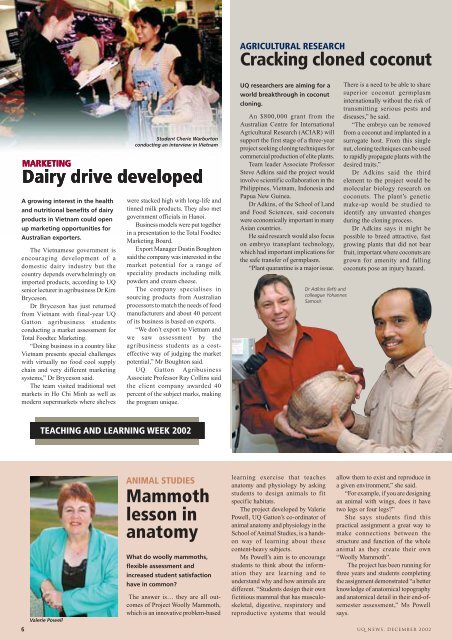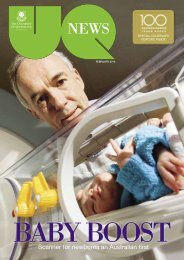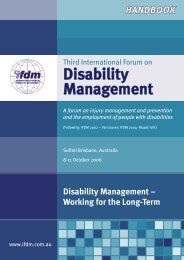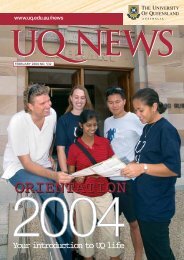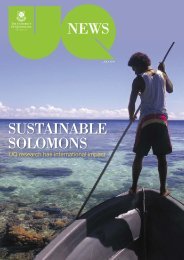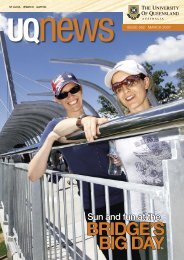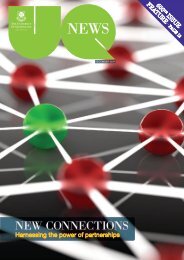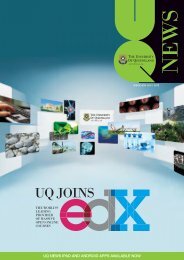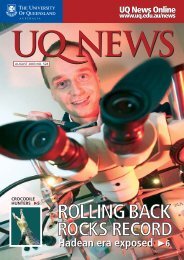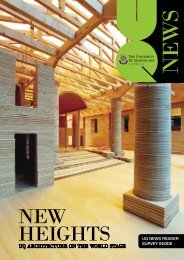01 cover - Office of Marketing and Communications - University of ...
01 cover - Office of Marketing and Communications - University of ...
01 cover - Office of Marketing and Communications - University of ...
You also want an ePaper? Increase the reach of your titles
YUMPU automatically turns print PDFs into web optimized ePapers that Google loves.
AGRICULTURAL RESEARCH<br />
Cracking cloned coconut<br />
MARKETING<br />
Dairy drive developed<br />
A growing interest in the health<br />
<strong>and</strong> nutritional benefits <strong>of</strong> dairy<br />
products in Vietnam could open<br />
up marketing opportunities for<br />
Australian exporters.<br />
The Vietnamese government is<br />
encouraging development <strong>of</strong> a<br />
domestic dairy industry but the<br />
country depends overwhelmingly on<br />
imported products, according to UQ<br />
senior lecturer in agribusiness Dr Kim<br />
Bryceson.<br />
Dr Bryceson has just returned<br />
from Vietnam with final-year UQ<br />
Gatton agribusiness students<br />
conducting a market assessment for<br />
Total Foodtec <strong>Marketing</strong>.<br />
“Doing business in a country like<br />
Vietnam presents special challenges<br />
with virtually no food cool supply<br />
chain <strong>and</strong> very different marketing<br />
systems,” Dr Bryceson said.<br />
The team visited traditional wet<br />
markets in Ho Chi Minh as well as<br />
modern supermarkets where shelves<br />
Student Cherie Warburton<br />
conducting an interview in Vietnam<br />
were stacked high with long-life <strong>and</strong><br />
tinned milk products. They also met<br />
government <strong>of</strong>ficials in Hanoi.<br />
Business models were put together<br />
in a presentation to the Total Foodtec<br />
<strong>Marketing</strong> Board.<br />
Export Manager Dustin Boughton<br />
said the company was interested in the<br />
market potential for a range <strong>of</strong><br />
speciality products including milk<br />
powders <strong>and</strong> cream cheese.<br />
The company specialises in<br />
sourcing products from Australian<br />
processors to match the needs <strong>of</strong> food<br />
manufacturers <strong>and</strong> about 40 percent<br />
<strong>of</strong> its business is based on exports.<br />
“We don’t export to Vietnam <strong>and</strong><br />
we saw assessment by the<br />
agribusiness students as a costeffective<br />
way <strong>of</strong> judging the market<br />
potential,” Mr Boughton said.<br />
UQ Gatton Agribusiness<br />
Associate Pr<strong>of</strong>essor Ray Collins said<br />
the client company awarded 40<br />
percent <strong>of</strong> the subject marks, making<br />
the program unique.<br />
UQ researchers are aiming for a<br />
world breakthrough in coconut<br />
cloning.<br />
An $800,000 grant from the<br />
Australian Centre for International<br />
Agricultural Research (ACIAR) will<br />
support the first stage <strong>of</strong> a three-year<br />
project seeking cloning techniques for<br />
commercial production <strong>of</strong> elite plants.<br />
Team leader Associate Pr<strong>of</strong>essor<br />
Steve Adkins said the project would<br />
involve scientific collaboration in the<br />
Philippines, Vietnam, Indonesia <strong>and</strong><br />
Papua New Guinea.<br />
Dr Adkins, <strong>of</strong> the School <strong>of</strong> L<strong>and</strong><br />
<strong>and</strong> Food Sciences, said coconuts<br />
were economically important in many<br />
Asian countries.<br />
He said research would also focus<br />
on embryo transplant technology,<br />
which had important implications for<br />
the safe transfer <strong>of</strong> germplasm.<br />
“Plant quarantine is a major issue.<br />
Dr Adkins (left) <strong>and</strong><br />
colleague Yohannes<br />
Samosir.<br />
There is a need to be able to share<br />
superior coconut germplasm<br />
internationally without the risk <strong>of</strong><br />
transmitting serious pests <strong>and</strong><br />
diseases,” he said.<br />
“The embryo can be removed<br />
from a coconut <strong>and</strong> implanted in a<br />
surrogate host. From this single<br />
nut, cloning techniques can be used<br />
to rapidly propagate plants with the<br />
desired traits.”<br />
Dr Adkins said the third<br />
element to the project would be<br />
molecular biology research on<br />
coconuts. The plant’s genetic<br />
make-up would be studied to<br />
identify any unwanted changes<br />
during the cloning process.<br />
Dr Adkins says it might be<br />
possible to breed attractive, fast<br />
growing plants that did not bear<br />
fruit, important where coconuts are<br />
grown for amenity <strong>and</strong> falling<br />
coconuts pose an injury hazard.<br />
TEACHING AND LEARNING WEEK 2002<br />
6<br />
Valerie Powell<br />
ANIMAL STUDIES<br />
Mammoth<br />
lesson in<br />
anatomy<br />
What do woolly mammoths,<br />
flexible assessment <strong>and</strong><br />
increased student satisfaction<br />
have in common?<br />
The answer is… they are all outcomes<br />
<strong>of</strong> Project Woolly Mammoth,<br />
which is an innovative problem-based<br />
learning exercise that teaches<br />
anatomy <strong>and</strong> physiology by asking<br />
students to design animals to fit<br />
specific habitats.<br />
The project developed by Valerie<br />
Powell, UQ Gatton’s co-ordinator <strong>of</strong><br />
animal anatomy <strong>and</strong> physiology in the<br />
School <strong>of</strong> Animal Studies, is a h<strong>and</strong>son<br />
way <strong>of</strong> learning about these<br />
content-heavy subjects.<br />
Ms Powell’s aim is to encourage<br />
students to think about the information<br />
they are learning <strong>and</strong> to<br />
underst<strong>and</strong> why <strong>and</strong> how animals are<br />
different. “Students design their own<br />
fictitious mammal that has musculoskeletal,<br />
digestive, respiratory <strong>and</strong><br />
reproductive systems that would<br />
allow them to exist <strong>and</strong> reproduce in<br />
a given environment,” she said.<br />
“For example, if you are designing<br />
an animal with wings, does it have<br />
two legs or four legs?”<br />
She says students find this<br />
practical assignment a great way to<br />
make connections between the<br />
structure <strong>and</strong> function <strong>of</strong> the whole<br />
animal as they create their own<br />
“Woolly Mammoth”.<br />
The project has been running for<br />
three years <strong>and</strong> students completing<br />
the assignment demonstrated “a better<br />
knowledge <strong>of</strong> anatomical topography<br />
<strong>and</strong> anatomical detail in their end-<strong>of</strong>semester<br />
assessment,” Ms Powell<br />
says.<br />
UQ NEWS, DecEMBER 2002


